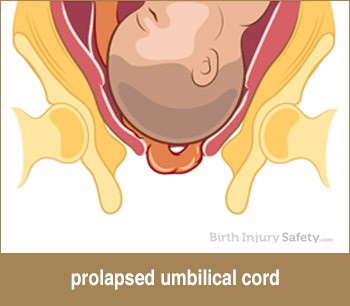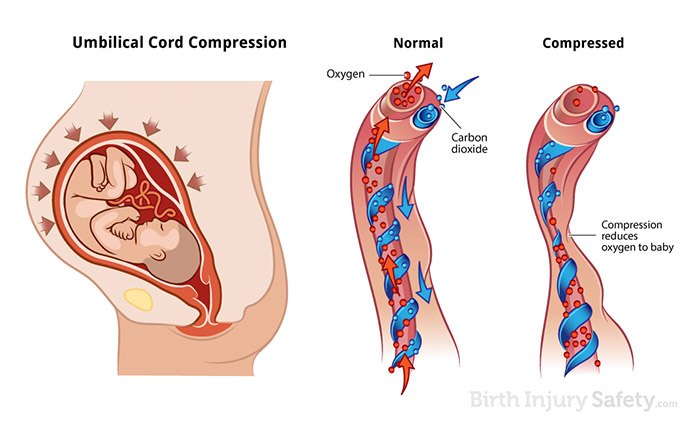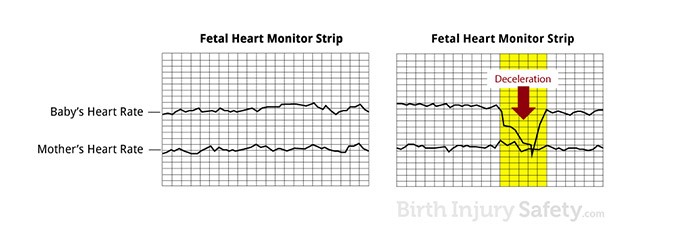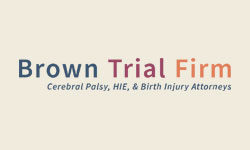What Is Umbilical Cord Prolapse?
The umbilical cord is a flexible tube-like structure that connects the baby to the mother during pregnancy. The umbilical cord is the baby’s lifeline. It carries oxygen and nutrients from the mother to the baby and carries away waste products.
Umbilical cord prolapse occurs when the umbilical cord slips into the birth canal after the membranes have ruptured, but before the baby descends into the birth canal. Umbilical cord prolapse poses a significant danger to the baby. The cord can become trapped against the baby’s body during delivery. As the baby passes through the birth canal, the baby puts pressure on the cord, which reduces or cuts off the oxygen supply to the baby. A prolapsed umbilical cord may present an emergency situation in which the baby must be delivered immediately or by Cesarean section to prevent umbilical cord compression.

The incidence of umbilical cord prolapse is estimated to be between 1.4 and 6.2 per 1000 pregnancies.1 Umbilical cord prolapse can be “occult” where the umbilical cord travels alongside the baby, and isn’t visible to doctors or nurses; or it can be “overt” where the umbilical cord protrudes in advance of the baby and is visible.
A common cause of umbilical cord prolapse is premature rupture of the membranes (PROM) that contain amniotic fluid. An umbilical cord prolapse can be detected by doctors and nurses by monitoring the fetal heart rate. If the umbilical cord prolapses, the baby’s heart rate may slow. The doctor or nurse may also see or feel the prolapsed cord during an examination.
What Is Umbilical Cord Compression?
The umbilical cord is the “lifeline” between the mother and the baby. Like a hose, it allows oxygen and nutrients to flow from the mother to the baby. Umbilical cord compression occurs when pressure causes this flow of blood to be reduced or stopped.
Causes of Umbilical Cord Compression
Umbilical cord compression can be caused by anything that leaves the cord compressed, squeezed, or kinked. Sometimes, the baby may roll over on the cord, or the cord may be compressed between the baby and the bones of the mother’s pelvis or other parts of the mother’s body. This compression may be temporary and may resolve quickly with no harm to the baby. However, if the compression doesn’t resolve, the disruption of the blood and oxygen flow can seriously injure or kill a baby.

Other causes of umbilical cord compression include:
- Nuchal cord: The umbilical cord becomes wrapped around the baby’s neck and may be wrapped tightly enough to slow or stop the flow of blood and oxygen. Nuchal cord is usually caused by the movement of the baby through a loop of the umbilical cord. One loop of umbilical cord around the baby’s neck happens in about 20% of pregnancies. Multiple loops happen in up to approximately 5% of pregnancies.
- Knot in the umbilical cord: A true knot in the umbilical cord can happen because of the movement of the baby in the mother’s uterus. A true knot is more likely to happen in early pregnancy when the baby is smaller, there is more amniotic fluid surrounding the baby, and the baby moves around in the uterus more.
- Umbilical cord prolapse: Part of the umbilical cord slips ahead of the presenting part of the baby and protrudes into the cervical canal or vagina.
Compression Can Cause Birth Asphyxia and Cerebral Palsy
The umbilical cord is the lifeline to the baby, so any condition that compresses, squeezes or kinks the umbilical cord can cut off the flow of blood and oxygen to the baby. If umbilical cord compression is not relieved, the baby may suffer from hypoxia (lack of oxygen in the blood), ischemia (lack of blood flow to the baby) and eventually birth asphyxia resulting in hypoxic-ischemic encephalopathy (HIE), brain damage, or death. When a baby isn’t getting enough oxygen, time is critical. Therefore, rapid recognition of the umbilical cord compression and immediate action are necessary to protect the baby and prevent injury.
Signs and Symptoms of Umbilical Cord Compression
During labor and delivery, mothers and babies are usually monitored with a fetal (baby) heart monitor. The fetal heart monitor detects and records the baby’s heart rate and the contractions of the mother’s uterus. One of the purposes of fetal heart monitoring is to detect changes in the baby’s heart rate that signal changes in the baby’s condition to warn the medical providers that the baby may be in danger.

Umbilical cord compression causes the baby’s heart to slow down or decelerate. Deceleration of the baby’s heart rate is a fetal heart rate pattern that should be detected on the electronic fetal heart monitor by doctors and nurses who are monitoring the baby’s heart rate. One of the fetal heart patterns that signals umbilical cord compression is a variable deceleration of the baby’s heart rate.
Risk Factors for Cord Compression
Certain conditions are risk factors for umbilical cord compression:
- Malpresentation: The baby is positioned in or descending through the birth canal in a position other than head down.
- Breech delivery where the baby is descending through the birth canal bottom first instead of head first;
- Transverse lie where the leading part of the baby in the birth canal is the baby’s arm, shoulder, or trunk. The baby is basically “sideways” in the birth canal;
- Oblique lie where the baby’s body and head are diagonal in the mother’s pelvis and the baby’s head is in the mother’s hip;
- Unstable lie where the baby’s position in the uterus continues to move and changes in the last two–three weeks of the pregnancy.
- Premature rupture of membranes (PROM): The mother’s membranes rupture (“water breaks”) early.
- Multiple gestation: Twins or triplets.
- Prematurity.
- Polyhydramnios: Excess amount of amniotic fluid in the amniotic sac.
- Long umbilical cord.
- Babies who are small for their gestational age (SGA) or have a low birth weight.
There are also obstetric procedures that are associated with umbilical cord compression, especially umbilical cord prolapse. Those obstetric procedures include:
- Artificial rupture of membranes: Medical provider intentionally breaks the mother’s water, especially when the baby’s presenting part is not engaged in the mother’s pelvis.
- Use of a balloon catheter to ripen the mother’s cervix.
- Use of forceps.
- Use of vacuum extractor.
- Amnioinfusion.
- Application of an internal scalp electrode.
- Insertion of an intrauterine pressure catheter.
Treatment for Umbilical Cord Compression
If the baby’s heart rate does not return to normal, the medical providers should provide interventions, including giving oxygen to the mother, changing the mother’s position, giving medications to slow the contractions, or performing an amnioinfusion to infuse fluids around the baby if the cord compression is due to decreased amniotic fluid. If the cord compression cannot be relieved, a Cesarean section may be necessary to deliver the baby before the lack of oxygen results in injury or death.
Preventable Birth Injuries Due to Lack of Oxygen
Not all umbilical cord problems can be prevented; however, umbilical cord compression causes signs and symptoms that are recognizable and there are treatments to protect the baby. As a result, many injuries and deaths from umbilical cord compression are preventable with proper medical care.
Umbilical cord compression can lead to abnormalities in the baby’s heart rate which should be recognized on the fetal heart monitor strip, prompting immediate medical action. When the baby does not get enough oxygen, this can cause damage to the baby’s brain and other vital organs which can result in hypoxic-ischemic encephalopathy (HIE), brain injury, cerebral palsy, and even death of the baby. Umbilical cord compression can be an obstetric emergency in which rapid recognition and prompt action is medically indicated and necessary. An emergency Cesarean section delivery may be necessary to protect the baby.
All medical personnel in the labor and delivery department should be trained to know and recognize the signs and symptoms of umbilical cord compression and to act quickly to provide the treatment necessary to protect the baby. Improper or insufficient training of nurses and doctors, delays in recognizing the signs of umbilical cord compression, and delays in performing Cesarean section delivery are known causes of birth asphyxia and birth injury to babies in labor and delivery.
When You Need a Birth Injury Attorney, Call Laura Brown
Birth injury claims are a type of medical malpractice case. The medical issues involved in birth injury lawsuits can be complex. Birth Injury Attorney Laura Brown has spent years researching and representing babies who have suffered birth asphyxia, hypoxic-ischemic encephalopathy, and cerebral palsy. If you have questions about whether or not your child’s injuries may be have been preventable, please call or email Laura Brown if you would like to schedule a free consultation to talk to her about what happened in your delivery and to find out if your baby’s injury was preventable.
Additional Information
- Umbilical Cord Complications
- Umbilical Cord Accidents
- Prolapsed Umbilical Cord – Merck Manual
- Umbilical Cord Complications
1Kahana B, Sheiner E, Levy A, et al. Umbilical cord prolapse and perinatal outcomes. Int J gynaecol Obstet. 2004;84: 127-132.
Have questions about a birth injury?
- Cerebral Palsy
- Caput Succedaneum and Cephalohematoma
- Neonatal Intracranial Hemorrhage (Childbirth Brain Bleeds)
- Hydrocephalus (Extra Fluid in the Brain Cavity)
- Cervical Dystonia
- Hemiplegia (Brain or Spinal Cord Injury)
- Hemorrhagic Stroke
- Neonatal Stroke
- HIE
- Periventricular Leukomalacia (PVL) Brain Injury
- Infant Seizures
- Spastic Diplegia (Spasticity in the Legs)
- Top Risks for Birth Injuries
- Fetal Alcohol Syndrome
- Facial Paralysis
- Spinal Cord Injuries
- Bell’s Palsy
- Brachial Plexus Nerves & Erb’s Palsy
- Klumpke’s Palsy
- G-Tubes for Newborns
- Medical Errors
- Cesarean Section & Birth Injury
- Negligence in Brain Cooling Treatment
- Craniosacral Therapy
- Occupational Therapy
- Speech Therapy
- Transition From Pediatric to Adult Healthcare
- Surgical Options for Spastic Cerebral Palsy
- Fetal Intolerance to Labor
- Jaundice (Kernicterus)
- Breech Position
- Placental Complications
- Umbilical Cord Problems
- Uterine Rupture
- Cervical Incompetence (Insufficiency)
- Blighted Ovum
- Necrotizing Enterocolitis (NEC) - Intestinal Inflammation
- Cephalopelvic Disproportion
- Meconium Aspiration Syndrome
- Amniotic Fluid Embolism
- Birth Injury from Premature Delivery
- Developmental Delays
- Abnormal Cord Insertion
- Infections at Birth
- Chorioamnionitis Bacterial Infection
- Premature birth
- Oxygen Deprivation
- Listeria
- Birth-Acquired Herpes
- Placenta Previa
- Placental Abruption
- Mismanaged Fetal Malposition
- Rapid Labor
- Obesity Related Birth Injuries
- Intrauterine Growth Restriction
- Blood Clots During Pregnancy
- Ectopic Pregnancy Misdiagnosis
- Myths & Facts About Birth Injuries
- Bacterial Vaginosis
- Gestational Diabetes
- Maternal Mortality Risk
- Oligohydramnios (Low Amniotic Fluid)
- Infections During Pregnancy
- Excessive Bleeding During Pregnancy
- Congenital Syphilis


